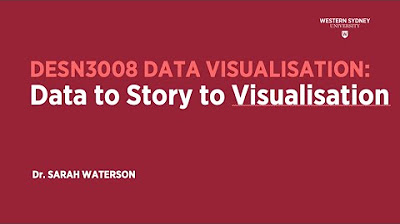How to declutter data visualizations (5 steps)
Summary
TLDRThis video explores effective data visualization and storytelling techniques, emphasizing the importance of simplicity and clarity. It covers key strategies such as legibility, removing unnecessary complexity, and using contrast to highlight key insights. Through practical examples, the speaker demonstrates how to declutter visuals and build a compelling narrative, ensuring data resonates with the audience. The presentation also stresses the value of engaging an audience by guiding their focus to critical data points and offering actionable recommendations based on visualized trends. Overall, it's a guide to telling clear, impactful stories with data.
Takeaways
- 😀 Legibility is crucial for effective data visualization. Ensure fonts and sizes are readable and visible in different settings.
- 😀 Avoid overcomplicating data visualizations. Keep things simple to prevent audiences from feeling overwhelmed or uninterested.
- 😀 Use visual affordances such as contrast to make certain elements stand out, guiding the audience's focus.
- 😀 When presenting data, use straightforward language and define any specialized terms to make the content accessible.
- 😀 Removing unnecessary complexity helps prevent confusion. Avoid adding elements that don't serve the story you're trying to tell.
- 😀 Start by stripping down your data visualization, then carefully build it back up to create a clear narrative for your audience.
- 😀 Use a minimalistic approach by removing things like gridlines, chart borders, and excess labels to declutter the visualization.
- 😀 When simplifying data, leverage the Gestalt principle of proximity by grouping related data together and ensuring a cohesive design.
- 😀 Employ contrast strategically by making the background elements subtle, which helps emphasize key data points.
- 😀 Storytelling with data is key. Present the data in a structured way that aligns with the message and guides the audience's understanding.
- 😀 Continuous feedback is important for ensuring your visualizations make sense to a wider audience. Test your visualizations with people who are less familiar with the topic to identify potential confusion.
Q & A
Why is it important to simplify data visualizations?
-Simplifying data visualizations is crucial because it helps the audience easily interpret and understand the data. Overcomplicating visuals can lead to confusion, misinterpretation, or disengagement, making it harder for people to absorb and act on the information.
What are the Gestalt principles, and how do they apply to data visualizations?
-The Gestalt principles refer to how people naturally group and organize visual elements. In data visualizations, they can help guide the audience’s attention to important elements by using principles such as proximity, similarity, and closure. This helps make data more intuitive and easier to understand.
How can contrast be used effectively in data visualizations?
-Contrast can be used to highlight important data points by making them stand out from less relevant information. By changing color, size, or emphasis, the designer can direct the audience’s attention to key insights, making the data more engaging and clearer.
What are the risks of overcomplicating a data visualization?
-Overcomplicating a data visualization can make the message unclear and lead to cognitive overload. This can result in the audience thinking the information is too complex, causing them to disengage or misunderstand the message, potentially leading to incorrect decisions.
Why is it important to define acronyms and specialized language in data presentations?
-Defining acronyms and specialized language is important to ensure clarity. Not everyone in the audience will be familiar with the terms, and failure to define them could lead to confusion or alienation. Clear explanations make the data accessible to a wider audience.
What does the term 'visual affordances' mean in the context of data visualization?
-Visual affordances refer to how visual elements can guide the viewer's perception and interaction with the data. In data visualization, this often means using contrast, alignment, and focus to draw attention to the most important elements, while minimizing distractions.
What is the 'strip down and build up' strategy in data visualization?
-The 'strip down and build up' strategy involves starting with a cluttered or overly complex visualization, removing unnecessary elements, and then gradually adding features back in to tell a clear, focused story. This helps reduce confusion and presents the data in a more digestible format.
How can you simplify a complex chart without losing key information?
-One approach is to reduce the number of elements in the chart, such as turning bars into lines or eliminating unnecessary grid lines and borders. You can also focus on using a common time axis and aligning data points to make comparisons easier, while ensuring the key message is still clear.
What role does legibility play in effective data visualization?
-Legibility is crucial in ensuring that the audience can read and understand the data. This includes choosing the right typeface, font size, and ensuring that text and numbers are visible from different distances, especially when presenting in a large room or through a projector.
How can feedback from someone outside the project help improve a data visualization?
-Getting feedback from someone outside the project can highlight areas where the data visualization may be too complex or unclear. They may ask questions that reveal potential issues with terminology, clarity, or the overall structure, helping to simplify and improve the communication of the message.
Outlines

此内容仅限付费用户访问。 请升级后访问。
立即升级Mindmap

此内容仅限付费用户访问。 请升级后访问。
立即升级Keywords

此内容仅限付费用户访问。 请升级后访问。
立即升级Highlights

此内容仅限付费用户访问。 请升级后访问。
立即升级Transcripts

此内容仅限付费用户访问。 请升级后访问。
立即升级浏览更多相关视频

Data Visualization Techniques | Data Visualization Techniques and Tools | Data Visualization Trends

DataVis : Pod 02 Data Storytelling overview

VISUALISASI INFORMASI: #5 - TAHAPAN VISUALISASI INFORMASI

Statistika 06 | Visualisasi Data dalam Statistika | Data Visualization | Belajar Statistika

Creating Designs

Pitch Your Ideas Better by Using the Magic of Visual Storytelling
5.0 / 5 (0 votes)
